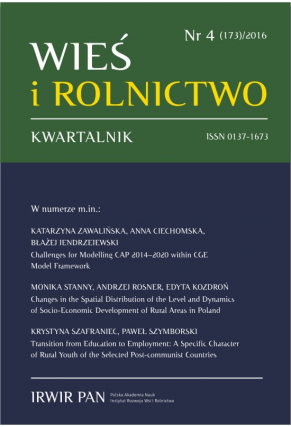Transition from Education to Employment: A Specific Character of Rural Youth of the Selected Post-communist Countries
DOI:
https://doi.org/10.53098/wir042016/06Keywords:
labour market, rural youth, post-communist countriesAbstract
The subject of analysis is the process of entering the labour market, considered in relation to the rural youth in selected post-communist countries (Poland, Romania, Russia, China and Vietnam). The empirical basis are different types of existing data (scientific monographs, papers, national and international reports, official statistics) collected in an international project funded by the National Science Centre, Poland. Transition from education to satisfactory employment which, at present times, takes almost the whole third decade of young people’s lives, is only an external indication of transformations in the labour markets all over the world. In the analysed group of the countries, Poland is the only case where both using new educational offers and positive valuation of living in the countryside occur to the extent unobserved in other countries; nevertheless, Polish young people also see their life opportunities in the cities where they compete for employment. Rural youth in all the analyzed countries usually represents the type of chaotic careers, situating it in segments of informal work, temporary or self-employment.References
Balica M. (2014). Rural-urban disparities in education – Romania. Materials (pptx presentation) from Polish and Romanian seminar organised in October 2014 in the Institute of Agriculture at the Romanian Academy, Bucharest.
Boyadjieva P., Ilieva-Trichkova P. (2015). Institutional Diversity and Graduate Employability. In: R.M.O. Pritchard, M. Klumpp, U. Teichler (eds), Diversity and Excellence in Higher Education: Can the Challenges be Reconciled? (pp. 153–171). Rotterdam: SensePublishers.
Catrina S. (2015). Lines of division and threats of social cohesion – towards the question on the role of youth in transition processes and social changes. Materials (pptx presentation) from the international seminar organised within NCN project in May 2015 in Sopot.
Chan C.K.-C., Ngai P. (2009). The making of a new working class? A study of collective actions of migrant workers in South China. China quarterly, June, 198, 287–303; http://burawoy.berkeley.edu/Public%20Sociology,%20Live/Pun%20Ngai/PunNgai.Protest.China%20Quarterly.pdf [accessed: 14.08.2016].
China Youth Employment Report – Analysis Report of China’s Survey on School to Work Transition. (2005). Youth Employment Network Office China Research Institute of Labor Sciences of Ministry of Labor and Social Security, International Labor Organization; http://www.ilo.org/beijing/what-we-do/publications/WCMS_158641/lang--en/index.htm [accessed:14.08.2016].
Chunling L. (2015). NEET phenomenon of youth after 80th and 90th in China. Journal of Chinese Youth Social Science, 4, p. 139 [in Chinese].
CIA database. The world fact book. https://www.cia.gov/library/publications/the-world-factbook/ [accessed: 14.08.2016].
Czarnowski S. (2006 [1935]). Ludzie zbędni w służbie przemocy. Miscellanea Anthropologica et Sociologica, 7, 95–101.
Elder S., Haas H., Principi M., Schewel K., International Labour Office. (2015). Youth and rural development: Evidence from 25 school-to-work transition surveys. Geneva: ILO; http://www.ilo.org/wcmsp5/groups/public/---dgreports/---dcomm/documents/publication/wcms_360558.pdf [accessed: 14.08.2016].
EUROSTAT database, http://ec.europa.eu/eurostat/data/database [accessed: 14.08.2016].
Hu Z., Peng X. (2015). Household changes in contemporary China: an analysis based on the four recent censuses. The Journal of Chinese Sociology, 2 (1), 1–20.
http://farmsubsidy.openspending.org [accessed: 14.08.2016].
International Labour Office. (2015). Global employment trends for youth 2015: Scaling up investments in decent jobs for youth. Geneva.
Ilieva-Trichkova P., Boyadjieva P. (2014). Dynamics of inequalities in access to higher education: Bulgaria in a comparative perspective. European Journal of Higher Education, 4 (2), 97–117.
ILOSTAT database, www.ilo.org/ilostat/faces/help_home/data_by_subject [accessed: 14.08.2016]
Knieć W. (2012). Wspólna Polityka Rolna a zrównoważony rozwój obszarów wiejskich Polski: Analiza socjologiczna. Toruń: Wydawnictwo Naukowe Uniwersytetu Mikołaja Kopernika.
Nowak L., Zakład Wydawnictw Statystycznych. (2013). Ludność Stan i struktura demograficzno-społeczna: Narodowy Spis Powszechny Ludności i Mieszkań 2011. Warszawa: Zakład Wydawnictw Statystycznych; http://stat.gov.pl/spisy-powszechne/nsp-2011/nsp-2011-wyniki/ludnosc-stan-i-struktura-demograficzno-spoleczna-nsp-2011,16,1.html [accessed: 14.08.2016]
Mukhanova M.N. (2014). Rural youth in Russia: Their status and prospects for development. Eastern European Countryside, 1, 125–150.
Nguyen An Ha. (2015). Youth participation in the adulthood, materials gathered for the purposes of the seminar within the frameworks of project Młodzież w krajach postkomunistycznych. May 2015: Sopot.
Nurzyńska I. (2016). Polska wieś i rolnictwo jako beneficjenci funduszy Unii Europejskiej. In: J. Wilkin, I. Nurzyńska (eds), Polska wieś 2016. Raport o stanie wsi. Warszawa: FDPA.
Survey assessment of Vietnamese youth 2: SAVY 2. 2010. Hanoi: General Office of Population and Family Planning.
Tang J. (2016). “Lost at the starting line”: a reconsideration of educational inequality in China, 1978–2008. The Journal of Chinese Sociology, 3 (1), 8; https://doi.org/10.1186/s40711-016-0028-z [accessed: 14.08.2016].
Tudor M.M. (2014). Romanian rural youth – socio-economic resilience factor. Materials (pptx presentation) from the international scientific conference: Młodzież w gospodarstwach rodzinnych i na obszarach wiejskich Europy, organised on 4–5 July 2014 by the University of Agriculture in Kraków.
Umbreş R., Sandu D., Stoica C.A. (2014). Romanian Youth: concerns, aspirations, attitudes and life style. Research report by the Center for Urban and Regional Sociology. CURS for Friedrich-Ebert-Stiftung Romania (FES); http://library.fes.de/pdf-files/bueros/bukarest/12141.pdf [accessed: 14.08.2016].
UN HABITAT & IESCO. (2015). China State of urban youth report 2014–2015. Equity employment and youth development in China. Overview and summary of findings; http://unhabitat.org/china-state-of-urban-youth-report-2014-2015 [accessed: 14.08.2016].
United Nations. (2006). Guide to the implementation of the World Programme of Action for Youth: Recommendations and ideas for concrete action for policies and programmes that address the everyday realities and challenges of youth. New York.
United Nations. (2014). Demographic Yearbook 2014; http://unstats.un.org/unsd/demographic/products/dyb/dyb2.htm [accessed: 14.08.2016].
Wasielewski K. (2013). Młodzież wiejska na uniwersytecie – droga na studia, mechanizmy alokacji, postawy wobec kształcenia. Toruń: Wydawnictwo Naukowe UMK.
Wilkin J. (2010). Czy paradygmat wielofunkcyjnego rolnictwa zrewolucjonizuje europejska politykę rolną? Podsumowanie badań i wnioski praktyczne. In: J. Wilkin (ed.), Wielofunkcyjność rolnictwa. Kierunki badań, podstawy metodologiczne i implikacje praktyczne. Warszawa: Instytut Rozwoju Wsi i Rolnictwa Polskiej Akademii Nauk.
Wilkin J., Nurzyńska I. (eds) (2016). Polska wieś 2016. Raport o stanie wsi. Warszawa: FDPA.
Xi J., Xia Y. (2006). Introduction to Chinese Youth (with a Commentary). DigitalCommons@University of Nebraska – Lincoln; http://digitalcommons.unl.edu/cgi/viewcontent.cgi?article=1001&context=cyfsfacpub [accessed: 14.08.2016]
Zhang J. (2004). China’s Skill Assessment System. Institute of Population and Labor Economics Chinese Academy of Social Sciences; http://siteresources.worldbank.org/EDUCATION/Resources/278200-1126210664195/1636971-1126210694253/China_Skills_Assessment.pdf [accessed: 14.08.2016].
Downloads
Article file downloads
Pages
How to Cite
Issue
Section
License
Copyright (c) 2016 Wieś i Rolnictwo

This work is licensed under a Creative Commons Attribution 4.0 International License.










